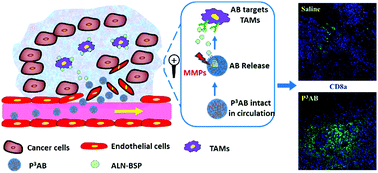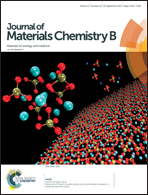A tumour microenvironment-responsive polymeric complex for targeted depletion of tumour-associated macrophages (TAMs)†
Abstract
Tumour-associated macrophages (TAMs) play pivotal roles in promoting cancer progression. Systemic delivery of therapeutic agents to efficiently eliminate these cells remains challenging. Here, we report the development of a bio-responsive polymeric complex (P3AB) that can be systemically administrated to target and eliminate TAMs in tumours. This complex comprises a polymeric ‘shell’ and ‘core’. The shell (PPP) consists of poly(ethylene glycol) (PEG), poly(lactic-co-glycolic acid) (PLGA), and a peptide that can be cleaved by matrix metalloproteases (MMPs) in the tumour microenvironment; and the ‘core’ (AB) is a bisphosphonate–glucomannan conjugate that has affinity for macrophage mannose receptors and selectively eliminates TAMs. Our data show that the P3AB complex can be accumulated in the tumour site thanks to its appropriate size and its PPP shell is sensitively cleaved by MMPs, efficiently releasing the AB core that can potently reduce TAM viability. The systemically delivered P3AB complex demonstrates favourable responses to the physiological features of the tumour microenvironment (e.g. underdeveloped vasculature and high MMP levels), and effectively inhibits tumour growth and restores local immunosurveillance in vivo, without exerting hepatotoxicity. Taken together, our findings suggest that P3AB has the potential to be an effective and safe tool for TAM-targeting cancer immunotherapy.

- This article is part of the themed collection: 2017 Journal of Materials Chemistry B HOT Papers


 Please wait while we load your content...
Please wait while we load your content...